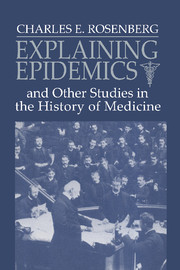Book contents
- Frontmatter
- Contents
- Acknowledgments
- Introduction: Why care about the history of medicine?
- I Ideas as actors
- II Institutions and medical care
- III The past in the present: Using medical history
- 11 The crisis in psychiatric legitimacy: Reflections on psychiatry, medicine, and public policy
- 12 Disease and social order in America: Perceptions and expectations
- 13 What is an epidemic? AIDS in historical perspective
- 14 Explaining epidemics
- 15 Framing disease: Illness, society, and history
- 16 Looking backward, thinking forward: The roots of hospital crisis
- Index
15 - Framing disease: Illness, society, and history
Published online by Cambridge University Press: 29 March 2010
- Frontmatter
- Contents
- Acknowledgments
- Introduction: Why care about the history of medicine?
- I Ideas as actors
- II Institutions and medical care
- III The past in the present: Using medical history
- 11 The crisis in psychiatric legitimacy: Reflections on psychiatry, medicine, and public policy
- 12 Disease and social order in America: Perceptions and expectations
- 13 What is an epidemic? AIDS in historical perspective
- 14 Explaining epidemics
- 15 Framing disease: Illness, society, and history
- 16 Looking backward, thinking forward: The roots of hospital crisis
- Index
Summary
This chapter too addresses the elusive problem of the ways in which society has understood, defined, and responded to disease. It was written originally to serve as the introduction to a volume made up of case studies in the framing of particular ills, ranging from coronary thrombosis to anorexia, from rheumatic fever to silicosis. I tried to categorize the kinds of factors – intellectual, attitudinal, professional, and public-policy – that enter into the complex negotiations through which society agrees to accept as legitimate the particular ills that have come to populate our nosological tables.
Medicine, an often-quoted Hippocratic teaching explains, “consists in three things – the disease, the patient, and the physician.” When I teach an introductory course in the history of medicine, I always begin with disease. There has never been a time when people have not suffered from sickness, and the physician's specialized social role has developed in response to it. Even when they assume the guise of priests or shamans, doctors are by definition individuals presumed to have special knowledge or skills that allow them to treat people experiencing pain or incapacity, unable to work or fulfill family or other social obligations.
- Type
- Chapter
- Information
- Explaining Epidemics , pp. 305 - 318Publisher: Cambridge University PressPrint publication year: 1992
- 11
- Cited by



